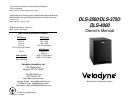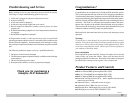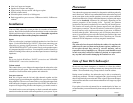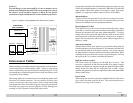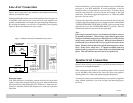
Installation
Your new DLS subwoofer system provides for a number of installation
options. Read all the installation information below in order to determine
which installation option is best for your system. Remember to perform
all installation procedures with system power turned off.
Inputs
Your new subwoofer is equipped with both speaker-level and line-level
inputs. Use the RCA/Phono type "INPUT" jacks when connecting your
subwoofer to a pre-amp, signal processor, or line-level crossover. The
"SPEAKER LEVEL-INPUT" jacks connect directly to the speaker outputs
of a integrated amplifier or receiver. Your amplifier section will notice no
additional loading effects when you use these inputs because of their high
impedance.
Note:
Do not use both the RCA/Phono "INPUT" connections and "SPEAKER
LEVEL-INPUT" connections simultaneously.
Volume control
This control allows you to balance the output from the subwoofer to the
main speakers in your system. This control should be set to achieve similar
volume level from both the main speakers and subwoofer.
Low-pass crossover
Both sets of inputs sum the left and right channels together and the
resulting signal is passed through an adjustable low-pass crossover before
being amplified. The crossover control allows you to adjust the upper limit
of the subwoofer's frequency response from 40 to 120 Hz. The subwoofer's
response will begin rolling off above the frequency you set this control to.
You should set the crossover frequency to obtain a smooth and seamless
transition from the subwoofer to the main speakers in your system. If your
3
☞
Placement
True subwoofers operate at extremely low frequencies which are primarily
omni-directional. While it is recommended that the subwoofers be placed
on the same plane as the satellite speakers, room and system conditions
often dictate otherwise. Keep in mind that frequency response and output
level can be drastically influenced by placement, depending on the
acoustic properties of the listening room. Typically, the optimum
location for a subwoofer is tucked away in a corner of your listening room.
This location will usually offer the greatest output levels and optimum
low frequency extension. The worst location for a subwoofer is typically
far away from any walls, and close to the center of your room. Avoid these
locations when possible. When using a pair of Velodyne subwoofers in
stereo, it is preferable to place each subwoofer by the satellite of the same
channel. Typically, a minimum distance of 4 to 5 feet from your TV to the
subwoofer will be adequate to avoid any magnetic interference.
Caution!
This subwoofer has electronics built into the cabinet. Do not place the
cabinet next to sources of heat such as furnace registers, radiators, etc.
Do not place the unit near sources of excessive moisture, such as
evaporative coolers, humidifiers, etc. The power cord should be routed
in such a way that it will not be walked on, pinched, or compressed in
any way that could result in damaging the insulation or wire.
Care of Your DLS Subwoofer
Do not use any harsh detergents or chemicals to clean the cabinet.
Abrasives, detergents, or cleaning solutions may damage the finish on the
cabinet. We recommend using a damp cloth to clean the cabinet.
During normal conditions, the subwoofer may be left on continuously
without any problems. The unit is equipped with a signal sensing circuit
that will automatically turn on the unit when a signal is present at the inputs
and turn off the unit after several minutes when there is no longer any signal
at the inputs.
If you plan to leave the unit unused for an extended period of time, we
recommend that you turn off the unit by the master power switch on the rear
panel.
continued. . .
8
☞
● Line-level inputs and outputs
● Speaker-level inputs and outputs
● Signal sensing auto turn on/off with bypass option
● Variable volume control
● Selectable phase control (0 or 180 degrees)
● Dual staggered low-pass crossover; 12dB/octave initial, 24dB/octave
ultimate



